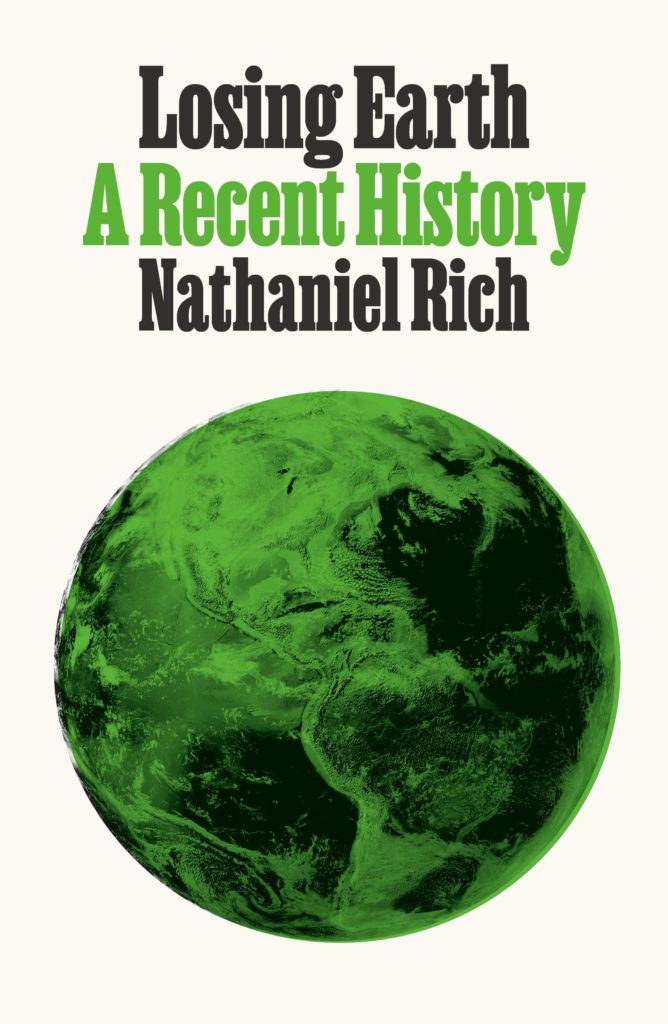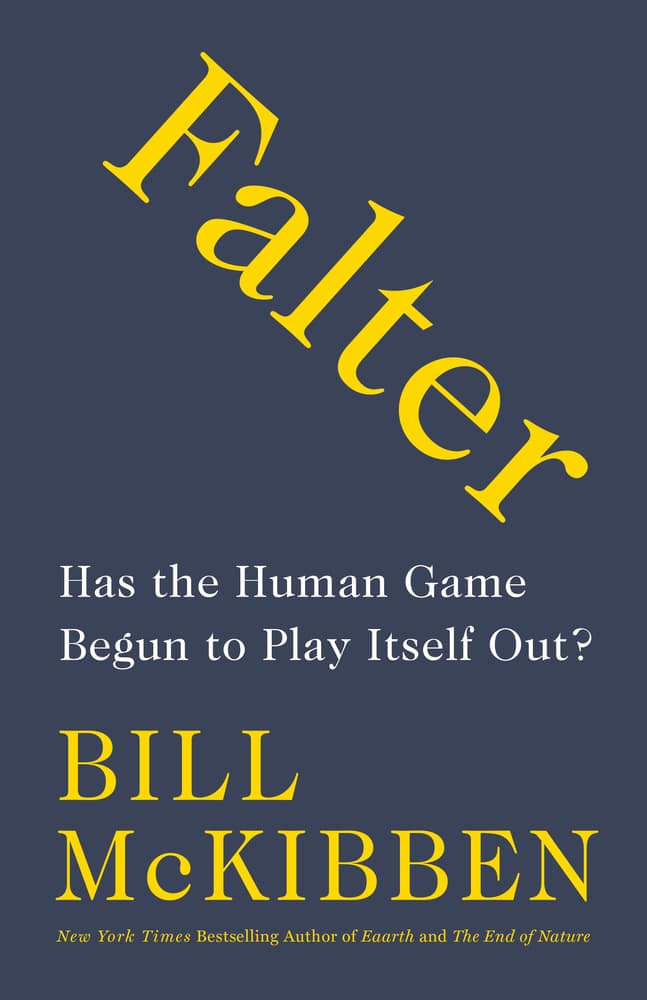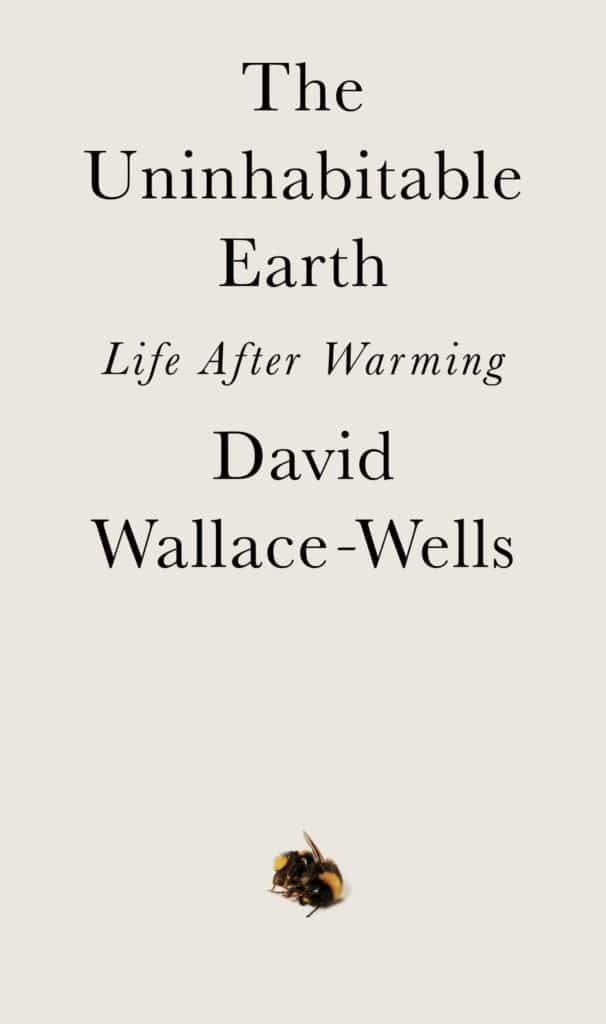Catastrophic Myopia
Review of
Falter: Has the Human Game Begun to Play Itself Out?
New York, NY: Henry Holt & Co., 2019, 304 pp.
Losing Earth: A Recent History
New York, NY: Farrar, Straus and Giroux, 2019, 224 pp.
The Uninhabitable Earth: Life After Warming
New York, NY: Tim Duggan Books, 2019, 320 pp.
There’s a lot of climate change catastrophe in bookstores these days.
Falter, by Bill McKibben. Losing Earth, by Nathaniel Rich. The Uninhabitable Earth, by David Wallace-Wells. Three makes a trend. Something about the present moment, or at least the interest of enough authors, publishers, and readers, has produced a surge in writing about the climate apocalypse.
These books cover similar territory, but they are not identical. To oversimplify the experience of reading them in succession, I found McKibben’s dominated by a millenarianism of climate change as world-transformative; Rich’s by a nostalgia for a past in which he imagines a few intrepid men could have stopped climate change in the 1980s; and Wallace-Wells’s by a profound despair rooted in apocalyptic visions of a warmer future. What they have in common, however, is that they reduce all human and natural stories to one: humanity’s carbon emissions. And ultimately, that’s their flaw. To say that anthropogenic climate change touches everything is fair; to place it at the center of all the problems and conflicts confronting human society, as these volumes end up doing, is less helpful.
The three books are extensions of each author’s previous climate writing. Wallace-Wells’s book is based on his 2017 cover essay of the same name—subtly illustrated with a screaming, sunglasses-wearing, fossilized human skull—in New York magazine. Rich’s 2018 long, two-part essay in the New York Times Magazine on “The Decade We Almost Stopped Climate Change” was the basis for his book. Bill McKibben draws from his 30-year career of writing and advocacy on the subject. They each inject an urgency, if by now a familiar one, into the conversation about climate change.

Certainly, when it comes to climate action, there’s no time like the present. Every year of rising global emissions does indeed accelerate humanity’s adventure into what is likely to be a disaster. Looking the problem in the eye and calling it by its name is never inappropriate. These volumes do so with analysis and prose better than most.
Still, it would be interesting and worthwhile to play whack-a-mole with some of the shaky claims found throughout these books. Books written and marketed as representing consensus physical and political science invite their own critique when they make sweeping, sketchy, or wholly mistaken claims. And sprinkled amid rock-solid scientific observations—about the reality of atmospheric warming, the seas rising before our eyes, and the likelihood of future impacts on weather, among other things—readers will find more opaque, questionable assertions. I could quibble with Wallace-Wells’s discussion of regional warming’s impacts on future grain yields, or Rich’s account of 1980s political economy, or McKibben’s Pollyannaish assessment of existing solar energy technologies.
But that is not my aim.
Rather, as someone who works in climate change day in and day out, I want to at least partially claw back the climate discourse from, well, every other discourse out there. It has become fashionable and wise to call climate change a “threat multiplier,” a far-reaching consequence of human actions that has the tendency to worsen many problems at once. But these books treat it more like a common denominator: the primary issue worthy of humanity’s attention, the one problem that underlies all the others.
The authors arrive at this common conclusion in different ways. Falter makes McKibben’s latest case for “eco-primitivism,” framing climate change as a totalizing human failure that encompasses greed, hubris, and social breakdown. Throughout all his writing, McKibben has envisioned more localism, less consumption, more decentralized production, and less growth. Like his “this changes everything” compatriot Naomi Klein, he uses climate change to rally for such a utopia. In Falter, as in previous work, McKibben betrays a strange agreement with his ostensible ideological foes: that economic growth and environmental sustainability are incompatible with each other. The disconnect with the rest of society is obvious, but even the vision is flawed: it is much more likely that we will manage climate change better as a richer, more interconnected, more technological planet, than the opposite.
Rich, for his part, imagines—both in some alternate 1980s timeline and in the actual future—that sufficient public attention and political will can push governments to do … something, anyway, to address this existential threat. But like most nostalgia, Rich’s confidence comes more from revisionist history than historical analysis. Perhaps there was a time past, in the same period that the United States joined the Montreal Protocol to protect the ozone layer and passed the sulfur-dioxide amendments to the Clean Air Act, when Democrats and Republicans really could come together to solve techno-social problems such as climate change. But the solutions to those problems, including alternatives to ozone-destroying chlorofluorocarbons, low-sulfur coal, and smokestack scrubbers, were much more readily available than climate solutions in the 1980s. In 2019, we barely have sufficient technologies available to clean carbon out of the electricity sector, let alone the other four-fifths of the global energy economy. That problem, and the international collective action problem posed by climate change, was significantly more severe 30 years ago.
Wallace-Wells’s book is probably the most popular of the three. Uninhabitable Earth makes a narrower argument than most books on the subject. And that argument is: we are doomed. The book relays his own conversion story from a relative lack of concern with a real but distant danger to his notion of “nature,” to a realization that climate change threatens literally everything. Wallace-Wells becomes his own synecdoche for all the reviewers and readers considering climate change for the first time. Yesterday, it was an abstraction; today, it is all-consuming.
In my day job, I think about the problem differently. I see climate change as, at bottom, a technological challenge. The most appropriate tools to manage climate change vary based on context, but they will tend toward the technological, the modern, and the dense: highly productive agriculture growing more food on less land, and energy abundance without the emissions—all feeding and powering a mostly urban planet. Significant innovation and acceleration of progress will be required, but the tools we will use to address global warming will owe a lot to the tools we’ve used to make society safer, richer, and healthier since at least the Industrial Revolution. Given this, I find all catastrophizing and the talk of climate change as an “unprecedented” challenge less convincing and helpful than McKibben, Rich, and Wallace-Wells intend.
And yet I can find some common ground with all the authors. McKibben acknowledges the same arc of progress I see in history, which he embodies throughout the book in the character of Steven Pinker, perhaps the world’s leading avatar of optimism and author of the 2018 bestseller Enlightenment Now: The Case for Reason, Science, Humanism, and Progress. What Pinker and the other prophets of progress get wrong, according to McKibben, is their confidence that the arc of progress can continue. I feel perhaps closest to Rich, who tries to construct a more hopeful technological and political trajectory, even if it’s detached from actual history. And I have to admire Wallace-Wells, who refuses to infuse his book with almost any hope at all (the first sentence of his book is “It is worse, much worse, than you think,” and it doesn’t get brighter from there). In contrast to Rich and McKibben, Wallace-Wells’s synthesis tilts mostly to the side of the problem, not the solutions. That makes it more coherent, in a way.
But in trying to dramatize the scale of the problem, all three authors ultimately paint the climate picture so large that it can’t be understood, let alone contained. There is a point at which making the case for action on a grand scale prevents us from figuring out and addressing the world’s many other problems—problems that may be much more tractable than the climate challenge. I’m afraid these books cross that Rubicon early in their pages and never look back.
Some things, such as sea level rise, can be clearly attributed to rising carbon dioxide emissions. (Although the solutions extend well beyond emissions reductions, to include wetland restoration, dikes, and, yes, managed retreat from threatened coastlines). Other attributions are more problematic. McKibben, for instance, asserts that “it’s a commonplace that record drought helped destabilize Syria.” Actually, the national security community is quite divided on this subject, and I haven’t found anyone outside the climate catastrophe set who routinely blames the Syrian civil war on carbon emissions. Wallace-Wells writes that rising heat waves will cause rates of murder and rape to rise—as if climate change should be the immediate concern of police departments or potential victims of assault. Hunger. Pandemics. Authoritarianism. Get to the bottom of it all and you find climate change.
It’s not that there is no truth to these relationships. We can and do find evidence of climate change affecting and usually exacerbating problems almost everywhere we look. The question is whether emissions are the best lens for peering at a problem. Doing so makes it too easy to assume the future is already written in emissions projections and climate model outcomes. The presence of human agency, the possibility of better-if-still-not-utopian outcomes, and the ability to creatively attack problems in the world are greatly diminished, and a variety of pragmatic, often piecemeal, approaches to problems are largely ignored by these authors.
To say that we should narrowly address sectarian violence, or crop productivity, or heat waves without entangling them with the challenge of reducing carbon emissions is not to say that climate change is not a problem. It is to say that humanity faces a huge variety of challenges, a changing climate among them, and that differentiating them is not only pragmatic but ambitious. We will better deal with the world’s many problems by not trying to deal with them all together.
Paths to addressing our problems might require new social arrangements, perhaps sometimes even in the localist direction McKibben would prefer. They might require a different politics, not unlike what Rich suggests. And though many social scientists have warned against paralyzing pessimism, I cannot bring myself to wag my finger too hard at the catastrophism in The Uninhabitable Earth—or in any of these books. They contain their author’s readings of the science, their considered warnings of coming danger, and their visions for a better future.
But they do not elevate the subject above the fundamental flaw of most climate writing: the treatment of carbon emissions as enveloping not just the atmosphere, but the human condition. If everything is climate change, then nothing is; if the only solution is to change everything, then there are no solutions. We would be better off if we broke the problem into its component parts, if we identified the likely causes of our problems and what solutions might alleviate them, up to and including rapid and deep reductions in emissions across all sectors. That means treating the problem comprehensively. It does not mean treating it singularly.


